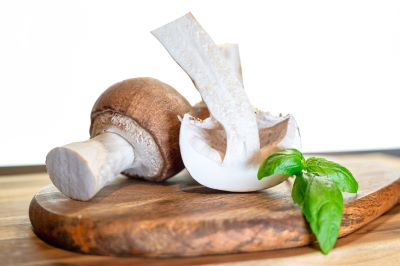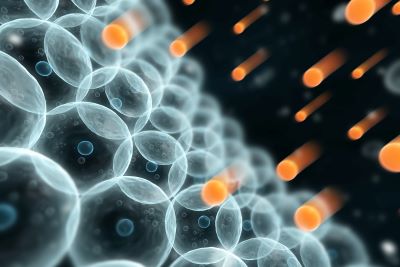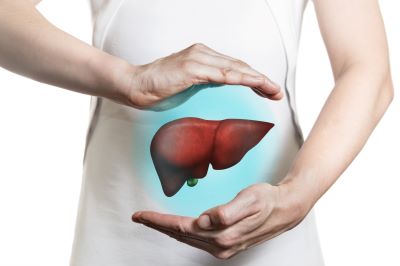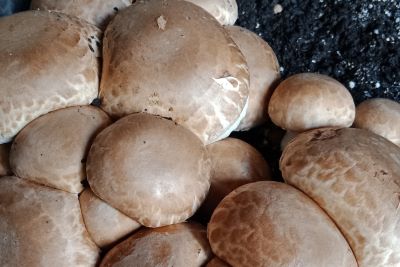Agaricus blazei murrill (ABM) – The vital mushroom for a strong immune system
Hardly any other mushroom strengthens and stabilises the immune system as effectively as the almond mushroom. Autoimmune patients in particular benefit from its balancing effect on the immune system. It is also a good support in the treatment of cancer and reduces oxidative stress in the body. Find out everything you need to know about this medicinal mushroom and how it can perhaps help you too.
What is Agaricus blazei murrill?
The vital mushroom that was discovered three times
The medicinal mushroom Agaricus blazei murrill, or “ABM” for short, has a rather unusual story to tell about its discovery. Its name comes from the biologist Murrill, who first described it in 1974. A few years later, however, it turned out that exactly the same mushroom was already listed under the name Agaricus brasiliensis. The epithet “brasiliensis” is derived from its home in the Brazilian rainforests. In 2005, scientists finally discovered during a DNA sequence analysis that the ABM or Agaricus brasiliensis has exactly the same genetic material as the Agaricus subrufescens Peck. This fungus had already been discovered and catalogued in 1893 by a researcher named Peck.
This story shows how difficult it is sometimes even for experts to clearly identify mushrooms. Nevertheless, ABM is now a widely used and popular medicinal mushroom in mycotherapy. We will stick to its most common name “Agaricus blazei murrill” and the abbreviation “ABM” in this article. In various countries, this medicinal mushroom has local names in addition to its biological name. In its home country Brazil, it has high-sounding titles such as “Cogumelo de deus” (Mushroom of God) and “Cogumelo do sol” (Sun Mushroom). It was given the latter name because of its preference for sunny locations, which is rather unusual among mushrooms. This characteristic also resonates in the English name “Royal Sun Agaricus”.
A relative of the mushroom
The name “Agaricus” refers to nothing other than the mushroom genus. Thus, the ABM is a relative of the mushroom Agaricus bisporus, which is commonly called “champignon” in our country. It is also very similar in appearance: It has the typical picture-book mushroom shape. It differs from the classic mushroom mainly in its size. The stalk of the Agaricus blazei murrill medicinal mushroom is between 10 cm and 14 cm long and 1.5 cm to 5 cm thick. When harvested, the stalk sometimes turns out to be hollow. The cap reaches a diameter of 12 cm to 14 cm. The colour of the almond mushroom varies from whitish and yellowish to light and dark brown depending on its age, and the lamellae can also take on all shades from white to dark brown.
As a secondary decomposer, Agaricus blazei murrill thrives primarily in soils that are rich in organic material that has already been decomposed by microorganisms. This substrate forms its nutritional basis. In its native Brazil, most specimens of this vital mushroom grow in the mountains of Piedade. They feel most at home in open areas at an altitude of around 800 m. Unlike most other mushrooms, the ABM loves the sun. Its preferred climate is 23 to 29 °Celsius and about 80 % humidity. The ideal growing conditions for the ABM in Piedade are from April to October. During this time, it forms its fruiting body.
Cultivation
The locals of Piedade have known the small, healthy almond mushroom for a very long time. When the mushroom is still young but sufficiently large, they collect it and use it as an aromatic ingredient in the kitchen. Researchers became aware of the ABM because Piedade’s inhabitants hardly suffered from degenerative old-age diseases such as dementia, diabetes or cancer. On closer inspection, they found a link to the consumption of this edible mushroom.
But it was the Japanese who were the first to attempt cultivation. In their homeland, they still cultivate the ABM under the name “Himematsutake”. However, the cultivated mushrooms are by no means only used in the cooking pot. In Japan as well as in the western USA, they are recognised as effective companions in cancer therapy. Today, relatively large cultivation facilities are found in Asia and South America. Nevertheless, you will rarely find the almond mushroom on the shelves of your greengrocer, as it is still one of the most expensive edible mushrooms in the world.
What’s in the ABM?
Like all edible mushrooms, the almond mushroom is an extremely healthy food. It is rich in protein, which accounts for up to 45% of its dry matter. It contains all the essential amino acids, i.e. those that have to be supplied to the body from outside. The fat content is rather low at less than 3 %. Nevertheless, the fatty acids, especially the polyunsaturated linoleic acid, play an important role for human health. The dietary fibres from the vital mushroom are also very valuable. They can account for up to 20 % of the dry mass. They include its most important health-promoting substances of all: the polysaccharides. In particular, the polysaccharide beta-D-glucan is contained in large quantities in ABM and supports the immune system in its work. Some polysaccharides combine with proteins to form glycoproteins. These also have a positive effect on our organism.
Other important substances in the treatment of diseases with the help of Agaricus blazei murrill are ergosterol, blazeispirol A and C, blazein, phenols and glucomannan. Trace elements and minerals are mainly:
– Magnesium
– Potassium
– Phosphorus
– Iron
– Copper
– Selenium
– Manganese (regulates insulin production)
– Zinc (strengthens the immune system).
As in many edible mushrooms, ABM contains several B vitamins, namely thiamine (B1), riboflavin (B2), niacin (B3) and B6. Its almond-like fragrance is due to its benzaldehyde content.
What effect does Agaricus blazei murrill have?
The spectrum of action of the almond mushroom is broad. First of all, it supports – like all other vital mushrooms – the detoxification of the body. A lower concentration of toxins is synonymous with a relief of the immune system and organs. In addition, its effectiveness in the treatment of cancer should be emphasised. We will go into these and other important areas of application of ABM in more detail in a moment. At this point, it should only be mentioned that the Brazilian vital mushroom also has antithrombotic and blood pressure-lowering properties in addition to the effects described below.
Cancer
Cancer is one of the most important areas of research in which scientists deal with the effect of ABM. In the PubMed medical database, for example, there are over 100 scientific articles on this topic. In Google-Scholar there are even more than 4000 hits. The use of Agaricus blazei murrill has already been shown to have a positive effect on the following types of cancer:
– liver cancer
– abdominal cancer
– colon cancer
– stomach cancer
– prostate cancer
– thyroid cancer
– pancreatic cancer
– lung cancer
– skin cancer
– liver cancer
– leukaemia
– brain tumours.
Researchers attribute the main effect to the beta-D-glucans contained in ABM. The glycoproteins probably also play an important role, whereby it is mainly the protein part that is important here. In addition, the blazeispirol A and C as well as the blazein have antitumour powers.
Fighting cancer on many levels
The decisive factor for the effectiveness of ABM is that it acts against the cancer on several levels at the same time. On the one hand, it prevents the proliferation of the tumour cells by hindering the work of the spindle apparatus and the centromeres. This makes it impossible for the tumour cells to duplicate their genetic material and continue to reproduce. On the other hand, the ingestion of Agaricus blazei murrill activates proapoptotic genes. Apoptosis is the cell death that is pre-programmed in every healthy cell. Since tumour cells have a greater resistance to this physiological mechanism, they live significantly longer to forever. The ABM counteracts this by activating apoptosis and at the same time causes the formation of important enzymes (e.g. caspase 3) for the degradation of the tumour cells.
In addition, there are the cytotoxic properties of some ingredients of the vital mushroom. Cytotoxic substances are able to damage or even kill tumour cells. Substances such as ergosterol from Agaricus blazei murrill also hinder the growth of tumours by preventing the formation of new vessels to supply the tumour. This effect is called “anti-angiogenic” in specialist circles. Ultimately, this medicinal mushroom reduces the risk of metastasis, which makes severe courses of disease less likely.
Companion to conventional cancer therapy
In Japan and the USA, ABM is rarely used as the sole therapeutic agent for cancer. Rather, doctors use it as a support for conventional treatment methods such as chemotherapy or radiotherapy. In this context, of course, it also unfolds its anti-tumour effects. Studies have shown that it also attenuates the side effects of conventional medical therapy and improves patients’ quality of life. For example, it supports the regeneration of the bone marrow, which enables the body to increase the decreasing blood formation again. As a result, there are fewer symptoms of exhaustion. Likewise, the immune system remains relatively strong, as more leukocytes are produced.
Especially the combination of orthodox medical therapy and taking ABM capsules has a strong stimulating effect on the TH1 immune response. This part of the immune system specifically targets degenerated cells and slows down tumour growth. Studies also showed that in patients with leukaemia or lymphoma, the administration of the medicinal mushroom reduces the swelling of the spleen.
Strengthening the immune system
In addition to zinc, beta-glucans and glycoproteins are primarily responsible for supporting the immune system.  The complex chemical structure of the polysaccharides triggers an equally complex cascade of effects. For example, they improve communication between the leukocytes, which are so important for defence, by stimulating the formation of cytokines and interleukins 8, 1 and 6. Similarly, ABM stimulates the proliferation and differentiation of macrophages and monocytes. As a result, the activity of the cytotoxic T-cells increases, which stimulate the B-cells to produce more antibodies by means of the cytokine IL-6. In addition, the ingredients of the Agaricus blazei murrill medicinal mushroom increase the formation of:
The complex chemical structure of the polysaccharides triggers an equally complex cascade of effects. For example, they improve communication between the leukocytes, which are so important for defence, by stimulating the formation of cytokines and interleukins 8, 1 and 6. Similarly, ABM stimulates the proliferation and differentiation of macrophages and monocytes. As a result, the activity of the cytotoxic T-cells increases, which stimulate the B-cells to produce more antibodies by means of the cytokine IL-6. In addition, the ingredients of the Agaricus blazei murrill medicinal mushroom increase the formation of:
– tumour necrosis factor alpha (apoptosis)
– natural killer cells
– immunoglobulin M (antibodies of the humoral immune defence)
– immunoglobulin G (antiviral and -bacterial)
Thanks to these multiple mechanisms, the intake of ABM provides a weakening of the symptoms of diseases such as bronchitis and HIV. In this context, its anti-inflammatory properties also play an important role. Over the years, the almond mushroom has also proven itself time and again in the treatment of migraine and chronic fatigue thanks to its immune-boosting powers.
As an adaptogen, Agaricus blazei murrill can not only increase immune activity, but also bring it into a healthy balance. That is why it is a helpful companion for allergies and asthma. Mycotherapists also like to use it for the following autoimmune diseases:
– Hashimoto’s thyroiditis
– Multiple sclerosis
– Rheumatism
– Chronic inflammatory bowel diseases (e.g. Crohn’s disease, ulcerative colitis)
– Fibromyalgia and other diseases.
With the almond mushroom against viruses and bacteria
In medical studies, Agaricus blazei murrill proves to be an efficient supporter in the fight against herpes simplex, polio as well as hepatitis B and C. It is also used in the treatment of AIDS patients. It even performs well in the treatment of AIDS patients. Scientists attribute its antiviral abilities on the one hand to substances that have a direct virucidal effect, i.e. they kill the viruses in the body. On the other hand, ABM prevents viruses from multiplying. It inhibits their replication by interfering with both virus binding and penetration.
In the fight against viruses as well as bacteria,  the immune-strengthening properties of the almond fungus naturally play a decisive role. This includes the above-mentioned stimulation of cytokines and interleukins as well as the formation of TNF alpha. In addition, Agaricus blazei murrill activates the complement cascade. As part of the innate immune system, it is responsible for the labelling of invaders and their dissolution. In an exemplary study, researchers dealt with the bacterium Streptococcus pneumoniae, which is considered a frequent pathogen of pneumonia, sinusitis, otitis media (middle ear infection) and also meningitis (meningitis). They had mice eat ABM regularly and observed their risk of infection with Streptococcus pneumoniae. It turned out to be significantly lower compared to mice that were not given ABM.
the immune-strengthening properties of the almond fungus naturally play a decisive role. This includes the above-mentioned stimulation of cytokines and interleukins as well as the formation of TNF alpha. In addition, Agaricus blazei murrill activates the complement cascade. As part of the innate immune system, it is responsible for the labelling of invaders and their dissolution. In an exemplary study, researchers dealt with the bacterium Streptococcus pneumoniae, which is considered a frequent pathogen of pneumonia, sinusitis, otitis media (middle ear infection) and also meningitis (meningitis). They had mice eat ABM regularly and observed their risk of infection with Streptococcus pneumoniae. It turned out to be significantly lower compared to mice that were not given ABM.
Reduce oxidative stress
Why do free radicals harm us?
Our cells are permanently exposed to oxidative stress. The causative agents, the free radicals, are a common by-product of natural metabolic processes. To a small extent, our organism can deal with them by making them harmless with the help of the body’s own antioxidants. An unhealthy lifestyle with a poor diet, alcohol consumption or a dysbalance of the processes in the body (e.g. through gradual and chronic inflammation, a leaky gut, anxiety or stress) leads to an increased occurrence of free radicals. Unfavourable environmental conditions such as high exposure to toxins, UV radiation or air pollution also increase oxidative stress. Among other things, the free radicals damage important proteins and lipids in the body as well as the DNA strands in the cells and the cell membranes. As a result, the organism ages faster and the risk of disease increases. Damage occurs to vessels, joints and organs. Ultimately, the entire cardiovascular system suffers from oxidative stress.
Antioxidant effects of ABM
Agaricus blazei murrill is the vital mushroom with the highest concentration of the antioxidant enzymes superoxide dismutase, tyrosinase and catalase. In addition, the enzyme peroxidase contained in ABM as well as the phenols and beta-glucans have the ability to bind free radicals.  Therefore, the medicinal mushroom is excellently suited to counteract oxidative stress and its consequences. The antioxidant effect can be directly measured by the indicator malondialdehyde, which shows the oxidation of lipids. It is so important because oxidised LDL cholesterol in particular is a major risk factor for plaques and thus arteriosclerosis. When ABM is administered, the malondialdehyde level drops significantly. In addition, physicians were able to demonstrate an improvement in iron complexation through the intake of the vital mushroom. Since free iron has a strong prooxidative effect, the binding of free iron atoms is synonymous with a decrease in oxidative stress.
Therefore, the medicinal mushroom is excellently suited to counteract oxidative stress and its consequences. The antioxidant effect can be directly measured by the indicator malondialdehyde, which shows the oxidation of lipids. It is so important because oxidised LDL cholesterol in particular is a major risk factor for plaques and thus arteriosclerosis. When ABM is administered, the malondialdehyde level drops significantly. In addition, physicians were able to demonstrate an improvement in iron complexation through the intake of the vital mushroom. Since free iron has a strong prooxidative effect, the binding of free iron atoms is synonymous with a decrease in oxidative stress.
The strong antioxidant properties of the medicinal mushroom Agaricus blazei murrill are helpful during chemotherapy, among other things, to prevent the development of new tumours due to the treatment. Furthermore, studies have shown positive effects in patients suffering from nerve diseases such as fibromyalgia, Parkinson’s disease or Alzheimer’s disease. Doctors also attribute the reduction of allergic symptoms, autoimmune diseases, protection of nerve cells in Parkinson’s disease and type 2 diabetes in part to the antioxidant effect of ABM.
Vital mushroom to protect the liver
In TCM and among mycotherapists, it is known that Agaricus blazei murrill protects and cares for the liver. Here, too, a range of mechanisms of action should be mentioned, all of which contribute in different ways to maintaining health. In connection with the antiviral properties, we have already mentioned that the ABM does a good job of fighting type B and C hepatitis viruses. In addition, taking the almond mushroom prevents an existing infection from becoming chronic. Thus, it offers some protection against cirrhosis of the liver.
However, our liver is not only threatened  by diseases. As a central detoxifying organ, it has to do heavy work all the time. If the pollutant load is high, this can permanently weaken or even damage the liver. That is why it is very positive news that Agaricus blazei murill efficiently protects the liver from toxins such as cadmium, carbon tetrachloride and nitrosamines in animal studies. The researchers attribute this effect to an increase in the enzyme glutathione peroxidase, which is enormously important for a functioning detoxification.
by diseases. As a central detoxifying organ, it has to do heavy work all the time. If the pollutant load is high, this can permanently weaken or even damage the liver. That is why it is very positive news that Agaricus blazei murill efficiently protects the liver from toxins such as cadmium, carbon tetrachloride and nitrosamines in animal studies. The researchers attribute this effect to an increase in the enzyme glutathione peroxidase, which is enormously important for a functioning detoxification.
In addition to toxins, it is above all an unfavourable composition of our nutrients that stresses the liver. This includes too much sugar as well as too much saturated fatty acids. Both are stored in the liver as energy reserves in the form of fat and can lead to a fatty liver over time. ABM now actively lowers the cholesterol and triglyceride levels in the blood, which means that less fat reaches the liver. A natural protective shield against stressful nutrients is also integrated into the intestinal flora. As the almond mushroom strengthens and maintains this shield, fewer stressful nutrients reach the liver overall.
What does ABM do for diabetes?
The anti-diabetic effect of the ABM vital mushroom also starts in the intestine. Here it inhibits the enzyme alpha-glucosidase, which leads to the intestinal mucosa absorbing fewer carbohydrates. As a result, blood sugar does not rise as much after a meal. By stimulating the islet cells of Langerhans, the medicinal mushroom also improves insulin secretion. As a result, the body can better regulate the blood sugar level.
For type 1 and also type 2 diabetics, it is also important that Agaricus blazei murrill protects the beta cells in the pancreas. They are the victims of the autoimmune process behind type 1 diabetes and the inflammatory one in type 2. In practice, the combination with the medicinal mushroom Coprinus comatus has proven effective here. If you suffer from diabetes yourself, it is best to ask our experts for advice on which combination and dosage of medicinal mushrooms is ideal for you.
Allergies
Here we discuss the role of the Agaricus blazei murrill vital mushroom in allergic reactions. The regular intake of Agaricus blazei murrill can reduce the risk of allergies and allergic symptoms. Its ingredients inhibit the release of histamine, the central messenger substance in an allergic reaction.
Mast cells, which are located in the skin and mucous membranes, are responsible for the release of histamine. When they come into contact with an allergen, they release the messenger substance. Among other things, the histamine increases the permeability of the blood vessels, the vessels dilate and, in the worst case, a so-called bronchospasm with respiratory distress occurs. Agaricus blazei murrill counteracts such reactions by reducing the amount of histamine released.
The continuous intake of the mushroom powder also has an immunomodulating effect. In this context, excessive immune reactions, which are typical for an allergy, are dampened. Experts often recommend allergy sufferers a combination of ABM and Reishi, as the two vital mushrooms complement each other very well in their immunomodulating effect.
Hints and tips for taking vital mushroom capsules
By taking vital mushrooms no serious side effects can occur. Nevertheless, an expert should always be consulted for the best possible effect. If you suffer from one of the problems described here and now think that Agaricus blazei murrill could help you, please first contact an experienced mycotherapist or our experts directly. When it comes to the dosage, various personal factors must always be taken into account. In addition, depending on the disease, the combination of several vital mushrooms is a good idea.
How is the ABM cultivated?
Although the largest quantities of the almond mushroom are cultivated in South America and Asia, there are also some mushroom farms in Europe that have the vital mushroom in their assortment. In Central Europe in particular, it is easy to grow in the summer months when the sun shines a lot and the temperatures are high enough. Artificially creating these conditions is possible, but quite energy-intensive and therefore cost-intensive.
 Different substrates are used as culture medium. However, their exact composition ultimately has a decisive influence on the ingredients of the ABM. In general, an organic material that is already decomposing is necessary for growth. In order not to harm your health, this substrate must not be contaminated with toxins or chemicals. The vital mushroom would otherwise absorb these pollutants directly and pass them on to you as the consumer. You are therefore on the safe side if you observe organic guidelines when growing mushrooms.
Different substrates are used as culture medium. However, their exact composition ultimately has a decisive influence on the ingredients of the ABM. In general, an organic material that is already decomposing is necessary for growth. In order not to harm your health, this substrate must not be contaminated with toxins or chemicals. The vital mushroom would otherwise absorb these pollutants directly and pass them on to you as the consumer. You are therefore on the safe side if you observe organic guidelines when growing mushrooms.
Where can I buy the ABM?
There are many shops for vital mushrooms on the internet. Before you decide on a particular supplier, check it thoroughly. In addition to comprehensive information on the mushrooms and the ingredients of the preparations offered, the shop should also list information on origin and cultivation conditions. The gold standard is always organic cultivation in Germany. Here you can be sure that no undesirable pollutants are contained in the mushroom preparation.
We also recommend buying capsules. In them, the powder of the vital mushroom is ready portioned and well protected from adverse environmental influences. This minimises the risk of mould. Make sure that the powder is made from the whole mushroom. A gentle drying process at below 40° Celsius is also essential to preserve all the important proteins and polysaccharides.
Note: The described effects are based on taking mushroom powder made from the whole mushroom. Please consult your therapist before use.
Sources:
- Nakajima A., Ishida T., Koga M., Takeuchi T., Mazda O.,Takeuchi M.: “Effect of hot water extract from Agaricus blazei Murill on antibody-producing cells in mice”; International Immunopharmacology 2 (2002) 1205-1211
- Cornelius, C.: “Comparative Enzyme Analysis…”; MRLNewsletter July 2009
- Prof. Dr. med. Ivo Bianchi: “Moderne Mykotherapie”; Hinckel Druck, 2008






